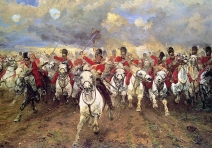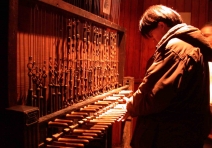LATEST WORLDWIDE TRAVEL NEWS

BELGIUM - WATERLOO
REZA'S RE-ENACTMENT REPORT
Waterloo is a small town 17 kilometers outside Brussels. This small hamlet in the province of Walloon became an important landmark on the world map as it was where Napoleon Bonaparte and the Duke of Wellington fought the deciding battle of the ‘Napoleonic War’ on 18th June 1815.
Although most of key offensives happened in Braine-l’Alleud, a commune that is adjacent to Waterloo, Wellington designated the battle after the name of Waterloo where his headquarters was located.
I was one of the 65,000 spectators who witnessed the recreation of the Battle of Waterloo, one of the largest re-enactments in the world so far, on the original grounds of the historical battle. The allied forces stood in colourful uniforms reminiscent of the original, against their French opponents to make history in one of deadliest battles of the world in a single day.
Although most of key offensives happened in Braine-l’Alleud, a commune that is adjacent to Waterloo, Wellington designated the battle after the name of Waterloo where his headquarters was located.
I was one of the 65,000 spectators who witnessed the recreation of the Battle of Waterloo, one of the largest re-enactments in the world so far, on the original grounds of the historical battle. The allied forces stood in colourful uniforms reminiscent of the original, against their French opponents to make history in one of deadliest battles of the world in a single day.
Before I could get a full-scale view of both armies in the field, which were surrounded by stands on both sides, cannon and gunfire clouded the air with foggy smoke. Often the visibility was limited and it became hard to see what was going on in the far distance. It must have been very similar on the day increasing the confusion and chaos which took place in the battle. I was standing behind the Allies’ artillery. The soldiers in dark uniforms were firing without any real cannon balls or bullets. Further down I could see a line of soldiers in red uniforms that were shooting their muskets and rifles into the air. Proud officers on horseback rode around the field watching over the infantry.
What I witnessed was just a show and far removed from the actual event. But the great performance transported me back in time to the real battle. I could hear the blast of the guns and the cries of the wounded soldiers. The battle presented a terrifying scene, a field covered by slaughtered humans and horses. There was no escape or protection for anyone when deadly mortar balls landed. Soldiers and artillery advanced forward but their progress was often hampered by the piles of dead and injured from both armies. When they got closer and engaged in hand to hand combat, the fighting got really tough as sword clashed on sword and the sounds of pistols firing broke through the clamour. The cavalry rode around the melee of fighting infantry slashing down venomously with their swords inflicting serious wounds. Ten hours of frantic fighting ended in the defeat of Napoleon’s 93,000 French troops by the 07,000 allied forces under Wellington’s command. A story that has stood for 200 years and should never be forgotten.
The men and women, enthusiasts and historians who participated in this once in a life time mass re-enactment spent hundreds of pounds on costumes and weapons and came together to stage the event as accurately as possible. To them it is not only a celebration of victory, but also a commemoration and tribute to those who died in that battle. The biggest show on earth was a live open-air history lesson including 6,200 re-enactors, 120 cannons, 330 cavalry and 2,000 infantry, watched by 64,000 spectators. Two metric tons of gunpowder were used over two days of reenactments.
The deadly confrontation of 1815 was not only a significant event that redrew the map of Europe, but also the clash of two ideologies, that of republicanism and aristocracy. Napoleon was a visionary with revolutionary ideas, looking for a free Europe. He was a man who rose to power through a revolution and managed to put together France, which was, when he came to power, in an acute period of political and civil unrest.
Napoleon was defeated in this monumental battle by the combined might of the rest of Europe, who were determined to stop him. Despite his reported expansionist and revolutionary ideas, which caused the death of approximately 65,000 soldiers, he was a well-respected and far sighted politician and successful military commander. Over the last two centuries historians have come to realise the brilliance of the young gunnery office from Corsica. Wellington’s victory made him a hero and he was honoured in England where he later became it’s Prime Minister. His name and that of Napoleon are often mentioned in the same sentence.
Napoleon’s defeat certainly ended 22 years of war and brought a period of peace and stability in Europe before the eruption of global wars in the 20th century. It is hard to imagine what Europe would have been like had Napoleon been victorious at Waterloo. France would have dominated in Europe and Napoleon would have invaded England to bring down the monarchy, abolishing the House of Lords and declaring a democratic rule of people (a republic). One side of the coin is that tyranny would have led to dictatorship and further wars and unrest in Europe and more expansion in other parts of the world. The other side would have heralded a new era for France with early industrial revolution and more prosperity.
Following the battle of Waterloo and an uprising in the Walloon region in 1830, Belgium was created with the support of Britain and become an independent county. The country is divided into two parts of Flanders (Dutch speaking) and Walloon (French speaking), an artificial creation to make a buffer zone between France and the Netherlands.
The Wellington Museum in Chausse de Bruxelles in the town of Waterloo was formerly a 17th century inn. It was the headquarters of Wellington and his staff during the battle and where he stayed on 17th and 18th June 1815. The museum houses the Duke’s bedroom, his office where he wrote his victory report, and his aide-de-camp’s bedroom. There are other rooms dedicated to each of the Allied armies. The museum also displays genuine documents, weapons and the uniforms of various nations.
The Wellington museum, as part of the 200th anniversary of the battle of Waterloo, put together a special commemorative exhibition, exploring the lives and paths of the two legendry commanders, Wellington and Napoleon, showing their shared destinies with a display of their personal belongings, such as Napoleon’s bicorn hat along with his uniform, and Wellington’s cape, hat and telescope. This special exhibition was only open until 31st July 2015.
The Memorial 1815 was inaugurated in May as part of commemoration of the battle and before the bicentenary ceremony. The memorial is a unique presentation of the history of the battle that welcomes visitors to the site of the battlefield. This museum offers a 4D audiovisual show and is a gateway to the site of the battlefield and also provides access to the Panorama and Lion’s Mound.
The Panorama is a circular building housing a painting of the battle. It is 110 meters long and 12 meters high in spherical form. The audio-guided experience gives the visitor the impression of being in the battlefield encircled by the infantry and cavalry of both armies.
The Lion’s Mound is positioned in Braine-l'Alleud at the place where the Prince of Orange was wounded during the battle. The Mound, which is 43 metres in height and gives visitors a panoramic view on the battle site, was constructed by the order of King William of the Netherlands and was completed in 1826.
Two other interesting places to visit are Quartier-Général de Napoléon Museum in the Caillou farmhouse and the Hougoumont Farm Memorial.
Napoleon spent the night before the Battle of Waterloo in a farmhouse which was converted to his headquarters. The museum includes his personal belongings, maps, weapons, paintings and other items related to the battle. The original dining table where Napoleon spread his map is also on display. The museum is located at Chaussée de Bruxelles 66, 4 kilometres away from the Lion’s Mound.
The Hougoumont Farm was opened to the public on 18th June 2015 after Prince Charles unveiled a memorial in tribute to British soldiers who were killed at the Battle of Waterloo. The ceremony was also a reunion of descendants of the three famous military commanders: Duke of Wellington, Prince Charles Bonaparte and Prince Blucher von Wahlstatt.
The battle site of Waterloo is a unique and historic must see experience for people of all ages.
For more information about Waterloo and Belgium, click here
For more images of Waterloo and videos click on www.amirinia.com/waterloo-2015 or click here.
You may also like to read

BELGIUM - WATERLOO COMMEMORATIONS 2015
2015 marks the 200th Anniversary of the Battle of Waterloo.

BELGIUM - THE BELLS ARE RINGING
Tour-smart's Anna Hyman listened to the bells, looked for lace and took a tour around the ancient Flemish city of Mechelen.


Comments